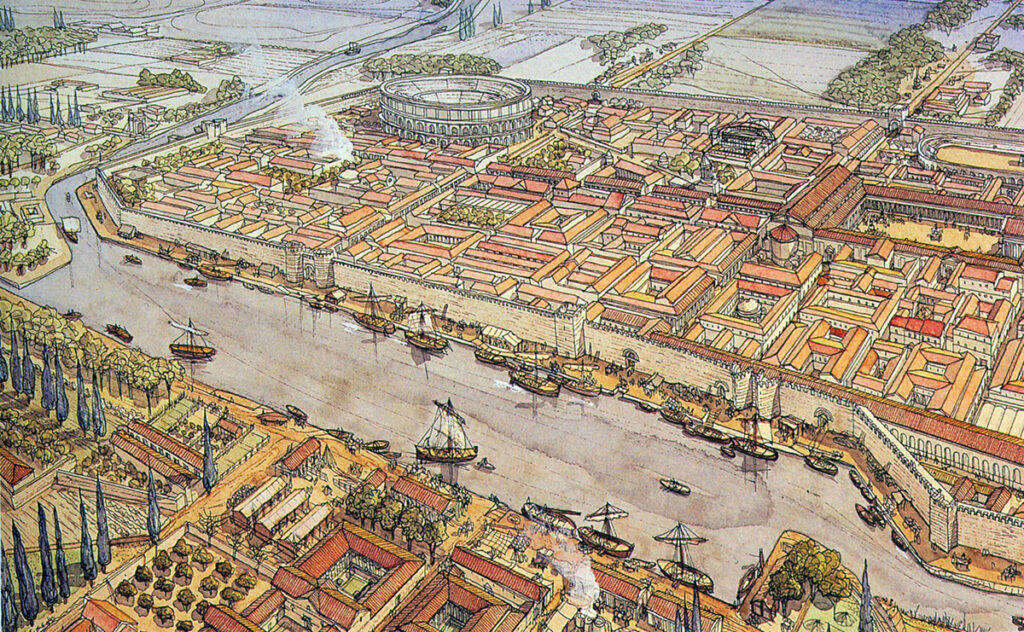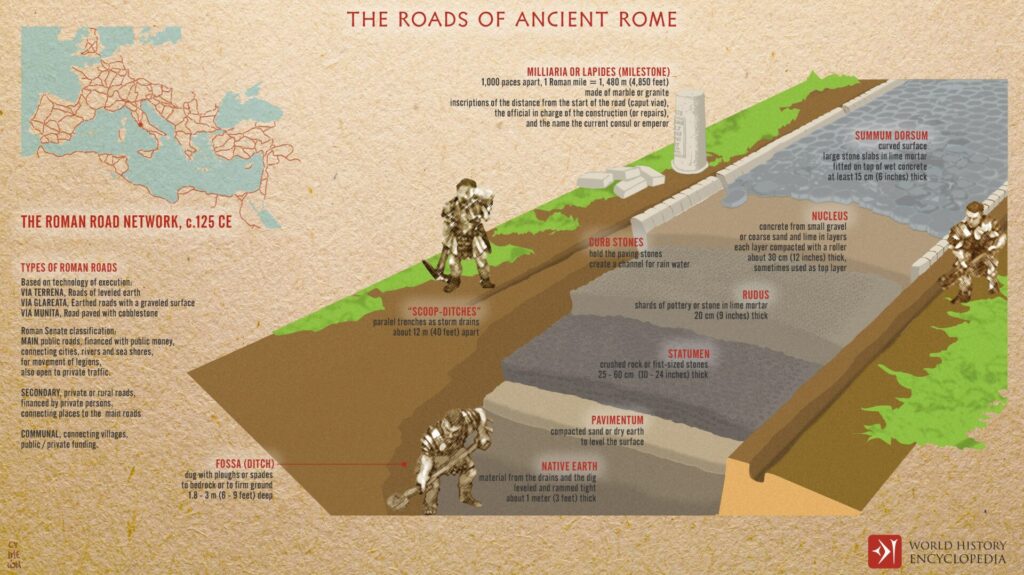The Roman Empire rose to be one of the most successful ancient civilizations. While many believe that warfare and taxes alone fueled this growth, the reality was more complex. As Rome expanded, the costs of running its vast territories grew. Leaders like Augustus had to look for new ways to support the Empire. Egypt soon became a key part of this plan, offering both wealth and important trade connections.
Once under Roman rule, Egypt’s resources and improved infrastructure brought in much-needed income. Renewed sea routes and the development of trade with eastern regions helped bring more merchants and goods to Rome. These changes supported the growth and stability of the empire for many years.
Key Takeaways
- Egypt played a vital role in the Roman Empire’s progress.
- Economic and administrative changes in Egypt increased trade and income.
- Roman control of Egypt positively influenced the Empire’s long-term stability.
Egypt’s Critical Role in the Roman Empire
Augustus’ Expansion into Egypt
When Augustus took control of Egypt, he gained more than just new land. He acquired a massive fortune by capturing local treasures and assets, including religious offerings and some of the wealth held by Egypt’s upper class. Augustus used this wealth not only to fund the state, but also to give out generous payments to Roman citizens and soldiers. This sparked a rise in spending and brought more foreign merchants into Rome, increasing the demand for goods.
Key Actions by Augustus:
- Confiscation of wealth from Egypt’s elite
- Large gifts given to Roman soldiers and people
- Direct investment in the Roman economy
Egypt’s Value to The Empire’s Treasury
Egypt provided crucial income to the Roman state. Taxation on goods imported through Egypt, especially from India and the East, became a big part of Rome’s yearly revenue. Under stronger Roman leadership, the government restored canals, roads, and ports. This made trade easier and safer. As trade increased, so did import and export taxes collected by officials.
| Type of Revenue | Approximate Amount (sesterces) |
|---|---|
| Annual import taxes (estimate) | 250 million |
| Tax from a single ship (“Hermit pollen”) | 2.2 million |
| Export tax from Egyptian goods | 25 million |
Restoring old mining operations also brought new materials and money into the empire.
Wealth Compared to Other Roman Regions
Egypt stood out among Roman provinces for its economic strength. While many newly conquered areas did not make enough money to cover their own expenses, Egypt sent significant wealth back to Rome. For instance, during Antony’s rule, Egypt and places like Gaul each gave the empire around 40 million sesterces a year. After Augustus took over and reformed its government, Egypt’s output grew far beyond that, especially as trade increased through its Red Sea ports.
Comparison with Other Regions:
- Many provinces operated at a deficit
- Anatolian territories were profitable, but Egypt’s revenues and trade potential quickly surpassed most other regions
- Import and export taxes from Egyptian trade made the region vital to imperial finances
Economic Changes During Roman Rule
Renewal of Farming and Upgrades to Infrastructure
The Romans quickly started fixing Egypt’s damaged canals and irrigation systems after taking control. These repairs were important for growing crops and for transporting goods. Roman soldiers, known for their building skills, helped restore roads and improve caravan routes across the country. New watchtowers and outposts were also built to keep trade routes safe for travelers and merchants.
Key actions taken:
- Restored canals and irrigation for better farming
- Built new roads and improved old ones
- Added safe stations and guard posts along trade routes

Boost in Trade and Better Transport
The Roman administration made shipping and trade between Egypt, India, and the Mediterranean much easier and safer. By securing the Red Sea ports and building cisterns filled with water for travelers, they encouraged traders to use these new routes often.
- Ship traffic from Egypt to India grew from under 20 ships a year to over 120 ships a year.
- Roman customs collected taxes on goods, bringing in large amounts of money.
- Popular trade goods included Eastern pepper, spices, and grain.
| Yearly Ships (Egypt–India) | Tax from One Example Ship | Total Import Tax (Estimate) |
|---|---|---|
| Less than 20 (before Rome) | 2.2 million sesterces | 250 million sesterces |
| Over 120 (after Rome) |
Use of Egypt’s Raw Materials
Under Roman rule, important natural resources in Egypt were heavily used. The Romans started mining for gold and emeralds in the desert again. They also reopened ancient quarries to get stones like porphyry and granite, which were used for art and buildings back in Rome. These resources provided income and material support for the Roman Empire.
Major resources used:
- Gold and emerald mines in the Eastern Desert
- Decorative stone quarries at Mons Porphyrites and Mons Claudianus
The Romans managed grain production and trade carefully to ensure resources flowed steadily from Egypt to the rest of the Empire.
Broadening Trade Across the East
Building Up Red Sea Harbors and Passageways
Roman control over Egypt led to major efforts to improve and expand ports along the Red Sea. Workers fixed up harbors and built new roadways to connect the Nile River to these ports. Roman forces also set up rest stops, storage tanks for water, and guard posts along travel routes. These changes made it easier and safer for traders moving between Egypt and distant markets.
Table 1: Improvements in Red Sea Trade Routes
| Area Improved | Type of Development |
|---|---|
| Ports | Upgrades and expansions |
| Roads | Repairs and new pathways |
| Water reserves | Cisterns for travelers |
| Security | Military outposts |

Increasing Ocean Trade with Indian Markets
After regaining control of Egyptian trade routes, there was a sharp rise in ships traveling from Egypt to India. Reports showed an increase from fewer than 20 vessels a year to over 120. Traders brought back valuable goods such as spices and pepper. Customs taxes on these imports became a major source of income for the empire.
Key Imports from India:
- Spices (especially pepper)
- Luxury goods
Key Facts:
- Each ship could carry goods worth millions in Roman currency.
- Taxes collected from one single ship could reach a quarter of its cargo’s value.
Steps Taken to Protect Merchants and Goods
Keeping traders safe was a top priority. The Romans put up watchtowers and stationed soldiers along popular trade roads. Guarded caravan stops were created to help travelers rest and protect their cargo. These actions lowered risks for merchants and encouraged more people to participate in trade.
Actions for Safety:
- Watchtowers along trade paths
- Military guards at key points
- Secure resting places for merchants
These measures improved confidence and helped boost commerce throughout the region.
Systems for State Revenue and Government Taxes
Trade Levies and Import Charges in Roman Egypt
Roman authorities put customs agents at busy eastern trade ports in Egypt. As ships brought goods like spices and pepper from India, officials charged heavy fees on imported items. The tax on these import shipments could be as high as 25% of the cargo’s value.
| Imported Item Type | Example Ship Value (sesterces) | Taxes Collected (sesterces) |
|---|---|---|
| Spices, Pepper, Others | 9,000,000 | 2,200,000 |
With over 120 ships sailing annually by the end of Augustus’s early rule, the state’s income from these taxes was large. Imports were also taxed at different stages once they entered the Roman heartland. The annual revenue from Mediterranean customs could add another 25 million sesterces.
Effects of Taxes on Goods Exiting the Empire
Exports, such as grain and other regional products, were also taxed. This helped the Empire raise even more money. Roman goods shipped out from Egyptian ports faced export duties before leaving for foreign markets.
- State export taxes amounted to around 25 million sesterces each year.
- The most common exports were cereals and agricultural produce.
These taxes helped the government fund its many expenses, including paying for military protection, public projects, and administration.
Financial Changes from Wealth Arriving in Rome
The influx of treasures and seized wealth, especially after the conquest of Egypt, changed the Roman economy. Early on, two-thirds of the riches of wealthy Egyptians and religious offerings were taken by Rome. Augustus then used this sudden wealth for several goals:
- He supplemented government spending on state needs.
- He handed out generous gifts to citizens and soldiers, boosting his popularity.
This sudden rise in available money led to a consumer boom, making goods like spices and luxury items more popular in the capital. Merchants and traders from other lands saw new chances for business, helping Rome become a busy international market where trade, new revenue streams, and taxes all played a role.
New Approaches to Administration and Rule
Changes to Regional Governance
Roman leaders developed stronger methods to manage their regions. They took over places with established systems, like Egypt and the territories in Anatolia, and made them official Roman provinces. These new systems included special officials for collecting taxes and managing trade. Local workers and former Greek administrators were sometimes kept in place but worked under Roman control.
Officials in each area were expected to keep order, collect money for Rome, and report back to the central government. They created rules to limit corruption and make sure money from exports, like grain and other goods, reached Rome.
Main Roles in Regional Management
| Official | Task |
|---|---|
| Provincial Governor | Supervise the province |
| Tax Collector | Gather taxes and revenues |
| Customs Agent | Check and tax goods |
Projects to Improve Roads, Defense, and Communication
The Romans restored and built new roads to help traders and soldiers move quickly. They set up caravan stops and military outposts along major routes. Watchtowers were constructed to help guard traders from bandits. These improvements made trade and communication between cities more reliable and safe.
Merchants benefited from cisterns, which held rainwater at intervals along desert paths, letting them travel longer distances. The Roman army played a major role, using its skills in construction to fix irrigation canals, restore farmland, and maintain river routes.
Key Features Built by Romans:
- Cisterns for water along desert routes
- Military outposts for safety
- Improved harbor and road networks

Blending Local Traditions with Roman Practices
Roman rulers kept some local practices but also changed others to fit their ways. Egyptian and Greek officials sometimes stayed in their roles but had to follow Roman instructions. Laws and trade systems combined customs from both the Romans and local peoples.
For example, local mines for gold, emeralds, and stones were now managed by Roman officials but used many local workers. The grain supply, a key resource, was controlled through a mix of old and new methods to make sure it got to Rome. Taxes were collected on goods as they entered and left the area, with both Roman and local systems used to check the shipments.
Blending Methods:
- Using local knowledge for trade and farming
- Roman laws applied to taxes and exports
- Shared responsibility for collecting and transporting goods
How Roman Success Was Shaped by Egypt
Economic Growth and City Expansion
After Rome took control of Egypt, the empire saw a jump in wealth. Leaders gained huge fortunes by seizing treasures and taxing the rich. Much of this money was spent on the public, including gifts to citizens and pay for soldiers.
This increase in spending led to more business and trade in Roman cities. Merchants from other regions came to sell their goods. Rome’s cities grew, both in size and in the number of people living there, making the empire busier and richer.
Changes to Ancient Trade Routes
With Egypt under Roman rule, new trade routes opened up from the Red Sea to India. Roads, caravan stations, and watchtowers were built to protect traders and goods. Travel became safer and easier.
New taxes on trade brought extra money into Rome. Ships carrying spices and other items from India and the East now left Egypt in large numbers. Traders paid customs fees, and Roman exports such as grain were taxed as well. The chart below shows how sea trade increased:
| Yearly Ships to India | Before Rome | Under Roman Rule |
|---|---|---|
| Less than 20 | ✓ | |
| Over 120 | ✓ |
Egypt’s Continued Role in Roman Society
Egypt’s land, mines, and skilled workers became important to Rome. Gold and emerald mines, stone quarries, and farmland were managed better after Roman leaders restored order.
Roman officials used systems set up by earlier Egyptian rulers and made them stronger. The grain and resources that flowed from Egypt helped feed Rome. Egypt kept its place as one of the most useful and valuable provinces in the empire.
